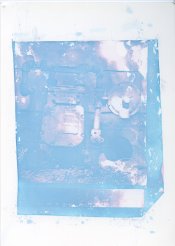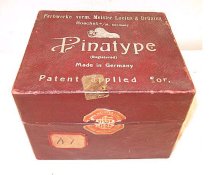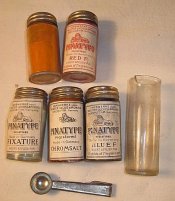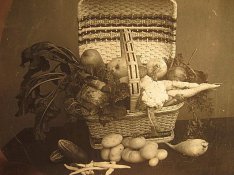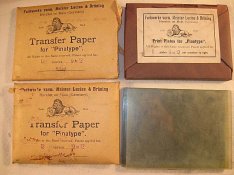holmburgers
Member
Eureka!
Well tonight turned out to be an exciting night for me. I created a dye image! I honestly did not expect to, but it just kind of happened. Allow me to explain...
I was exposing some of the DCG matrices, at 10 minutes, 20 minutes and 30 minutes; using 2 CFL blacklights. In each one (after a hot water etch) I could spot a relief image, but it was incredibly hard to see, so I thought 'ahh what the heck' and soaked one of the matrices in some water with half a dozen drops of blue food dye. Then it occurred to me to throw in some vinegar, since it's acid that gives the dye an affinity for gelatin. Lo & behold, after several minutes of soaking, you could spot a faint image in the matrix. The next logical thing was to slap it down on a piece of paper and see what happens. I rubbed a bit of vinegar on a fixed out sheet of RC paper and squeegeed the matrix onto it. 10 minutes or so later I peeled it off to reveal this image.
It's very humble of course, but I could not believe how good it looks considering. For one, it was a food dye, off the shelf from a grocery store! 2nd, absolutely no measuring of either the dye or the acid or timing of the soak or transfer and not to mention the use of vinegar in lieu of acetic acid. 3rd, no special receiving paper or mordant treatment.
The print shows all sorts of flaws that can and will be eliminated. My sensitized matrices were incredibly splotchy and dried puddles of PD created regions of opacity. I've got to get a better sensitizing procedure than soaking I'm afraid, though better squeegee practices might do the trick. Also, the transfer was pretty basic; just slap it down and wipe it flat with a wet sponge. I need to find a good rolling pin that is suitable.
The sharpness is surprisingly good, considering that I kept the negative in a polyethylene sleeve for the exposure and exposed through the base of the matrix film. My UV-light is by no means a point source and was not that high above the printing frame (1 foot tops).
My goal is to make dye-transfer viable for anyone who wants to do it.
Well tonight turned out to be an exciting night for me. I created a dye image! I honestly did not expect to, but it just kind of happened. Allow me to explain...
I was exposing some of the DCG matrices, at 10 minutes, 20 minutes and 30 minutes; using 2 CFL blacklights. In each one (after a hot water etch) I could spot a relief image, but it was incredibly hard to see, so I thought 'ahh what the heck' and soaked one of the matrices in some water with half a dozen drops of blue food dye. Then it occurred to me to throw in some vinegar, since it's acid that gives the dye an affinity for gelatin. Lo & behold, after several minutes of soaking, you could spot a faint image in the matrix. The next logical thing was to slap it down on a piece of paper and see what happens. I rubbed a bit of vinegar on a fixed out sheet of RC paper and squeegeed the matrix onto it. 10 minutes or so later I peeled it off to reveal this image.
It's very humble of course, but I could not believe how good it looks considering. For one, it was a food dye, off the shelf from a grocery store! 2nd, absolutely no measuring of either the dye or the acid or timing of the soak or transfer and not to mention the use of vinegar in lieu of acetic acid. 3rd, no special receiving paper or mordant treatment.
The print shows all sorts of flaws that can and will be eliminated. My sensitized matrices were incredibly splotchy and dried puddles of PD created regions of opacity. I've got to get a better sensitizing procedure than soaking I'm afraid, though better squeegee practices might do the trick. Also, the transfer was pretty basic; just slap it down and wipe it flat with a wet sponge. I need to find a good rolling pin that is suitable.
The sharpness is surprisingly good, considering that I kept the negative in a polyethylene sleeve for the exposure and exposed through the base of the matrix film. My UV-light is by no means a point source and was not that high above the printing frame (1 foot tops).
My goal is to make dye-transfer viable for anyone who wants to do it.





